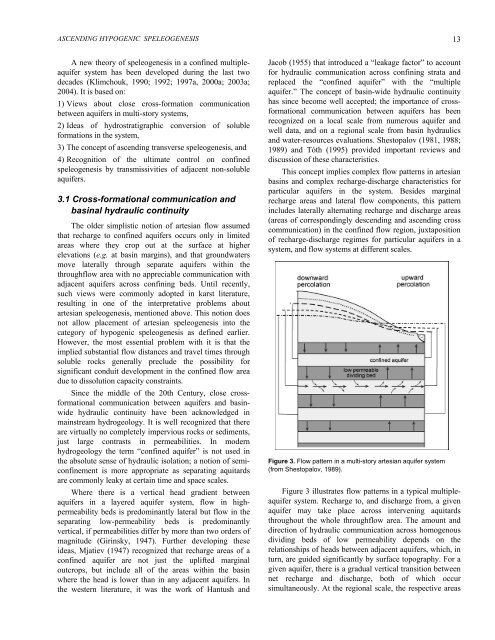Download PDF - Speleogenesis
Download PDF - Speleogenesis
Download PDF - Speleogenesis
Create successful ePaper yourself
Turn your PDF publications into a flip-book with our unique Google optimized e-Paper software.
ASCENDING HYPOGENIC SPELEOGENESIS<br />
A new theory of speleogenesis in a confined multipleaquifer<br />
system has been developed during the last two<br />
decades (Klimchouk, 1990; 1992; 1997a, 2000a; 2003a;<br />
2004). It is based on:<br />
1) Views about close cross-formation communication<br />
between aquifers in multi-story systems,<br />
2) Ideas of hydrostratigraphic conversion of soluble<br />
formations in the system,<br />
3) The concept of ascending transverse speleogenesis, and<br />
4) Recognition of the ultimate control on confined<br />
speleogenesis by transmissivities of adjacent non-soluble<br />
aquifers.<br />
3.1 Cross-formational communication and<br />
basinal hydraulic continuity<br />
The older simplistic notion of artesian flow assumed<br />
that recharge to confined aquifers occurs only in limited<br />
areas where they crop out at the surface at higher<br />
elevations (e.g. at basin margins), and that groundwaters<br />
move laterally through separate aquifers within the<br />
throughflow area with no appreciable communication with<br />
adjacent aquifers across confining beds. Until recently,<br />
such views were commonly adopted in karst literature,<br />
resulting in one of the interpretative problems about<br />
artesian speleogenesis, mentioned above. This notion does<br />
not allow placement of artesian speleogenesis into the<br />
category of hypogenic speleogenesis as defined earlier.<br />
However, the most essential problem with it is that the<br />
implied substantial flow distances and travel times through<br />
soluble rocks generally preclude the possibility for<br />
significant conduit development in the confined flow area<br />
due to dissolution capacity constraints.<br />
Since the middle of the 20th Century, close crossformational<br />
communication between aquifers and basinwide<br />
hydraulic continuity have been acknowledged in<br />
mainstream hydrogeology. It is well recognized that there<br />
are virtually no completely impervious rocks or sediments,<br />
just large contrasts in permeabilities. In modern<br />
hydrogeology the term “confined aquifer” is not used in<br />
the absolute sense of hydraulic isolation; a notion of semiconfinement<br />
is more appropriate as separating aquitards<br />
are commonly leaky at certain time and space scales.<br />
Where there is a vertical head gradient between<br />
aquifers in a layered aquifer system, flow in highpermeability<br />
beds is predominantly lateral but flow in the<br />
separating low-permeability beds is predominantly<br />
vertical, if permeabilities differ by more than two orders of<br />
magnitude (Girinsky, 1947). Further developing these<br />
ideas, Mjatiev (1947) recognized that recharge areas of a<br />
confined aquifer are not just the uplifted marginal<br />
outcrops, but include all of the areas within the basin<br />
where the head is lower than in any adjacent aquifers. In<br />
the western literature, it was the work of Hantush and<br />
Jacob (1955) that introduced a “leakage factor” to account<br />
for hydraulic communication across confining strata and<br />
replaced the “confined aquifer” with the “multiple<br />
aquifer.” The concept of basin-wide hydraulic continuity<br />
has since become well accepted; the importance of crossformational<br />
communication between aquifers has been<br />
recognized on a local scale from numerous aquifer and<br />
well data, and on a regional scale from basin hydraulics<br />
and water-resources evaluations. Shestopalov (1981, 1988;<br />
1989) and Tóth (1995) provided important reviews and<br />
discussion of these characteristics.<br />
This concept implies complex flow patterns in artesian<br />
basins and complex recharge-discharge characteristics for<br />
particular aquifers in the system. Besides marginal<br />
recharge areas and lateral flow components, this pattern<br />
includes laterally alternating recharge and discharge areas<br />
(areas of correspondingly descending and ascending cross<br />
communication) in the confined flow region, juxtaposition<br />
of recharge-discharge regimes for particular aquifers in a<br />
system, and flow systems at different scales.<br />
Figure 3. Flow pattern in a multi-story artesian aquifer system<br />
(from Shestopalov, 1989).<br />
Figure 3 illustrates flow patterns in a typical multipleaquifer<br />
system. Recharge to, and discharge from, a given<br />
aquifer may take place across intervening aquitards<br />
throughout the whole throughflow area. The amount and<br />
direction of hydraulic communication across homogenous<br />
dividing beds of low permeability depends on the<br />
relationships of heads between adjacent aquifers, which, in<br />
turn, are guided significantly by surface topography. For a<br />
given aquifer, there is a gradual vertical transition between<br />
net recharge and discharge, both of which occur<br />
simultaneously. At the regional scale, the respective areas<br />
13
















